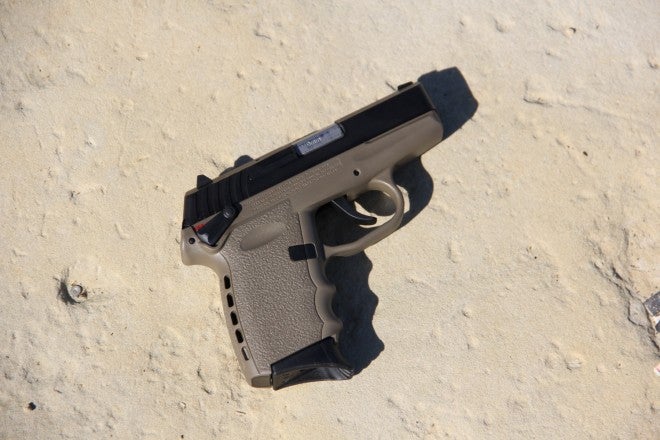I first became acquainted with the Sccy pistol line while working at a gun store in Southern Colorado. Our little hole in the wall shop had received one of their early production handguns, and the owner liked it enough to carry around in a small pistol holster in the shop on a daily basis.
Fast forward to two weeks ago, and I’m out in a sandy, central Texas range shooting the CPX-1 for the first time. The handgun is fairly small and light, about the same size as a Ruger LC9, the sights are large and familiar enough for my Glock-attuned eyes to use easily, and the grip, though not ideal (for me, that’s a Glock 17 or Browning Hi-Power), seems comfortable enough. I’m not a handgun guy; I really prefer practicing marksmanship fundamentals on a rifle while slung up in a GI web sling and shooting at a target as far away as the range allows, to standing in an isosceles stance, trying to control a little gun that wants to fly out of my hands. For me, that’s what all pistols feel like; I’ve been thoroughly spoiled by all the points of contact afforded by my coveted stocks and slings.
But even I can tell you the Sccy’s trigger has got to go. (More on that later in the article.)
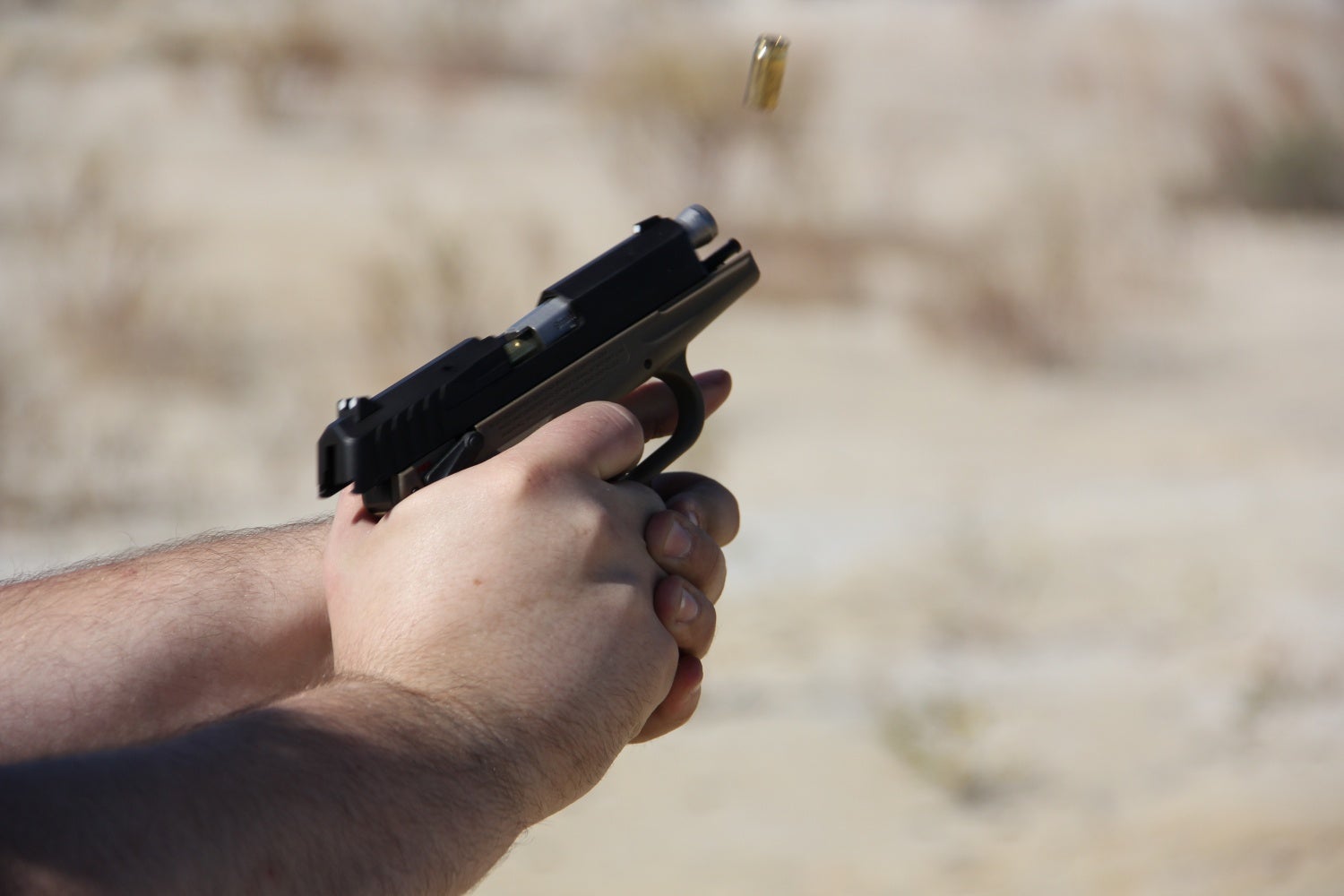
The Sccy CPX-1 pistol returning to battery. While it certainly wasn’t as controllable as my Glock 19, it wasn’t difficult to control compared to other compact 9mm handguns.
Having said that, the gun is a strong contestant in the concealed handgun market. The weapon is a well-made, if unremarkable, tilting-barrel-locking, recoil-operated handgun, with a hammer-fired mechanism. The machining was well done (it had all the hallmarks of being done via CNC, though I can’t confirm this), and the polymer elements were not poorly molded, nor did they have any defects. One of its few interesting design features is an aluminum frame and guide rail unit that is the serialized part, attached to which is the replaceable polymer grip. In the event that different OEM or aftermarket grips become available, the user of a Sccy can replace the grips without having to fill out another 4473. While right now this doesn’t seem to be much of a feature, it does speak to the thought that went into the design. During the somewhat limited string of fire I put it through, it was as reliable as Browning tilting-barrel locking firearms have become known for. This handgun certainly did not require a break-in period.
The finish of the slide of the Sccy was an attractive black nitriding over stainless steel, which unfortunately had already begun showing spots of rust by the time the pistol found its way to me. This is a minor issue; stainless steel, while less susceptible to tarnish, will rust like any other steel with neglect, and I was not the first user of this handgun. I recommend Sccy owners keep their handguns well-oiled to prevent this. The serialized aluminum frame insert was anodized black.
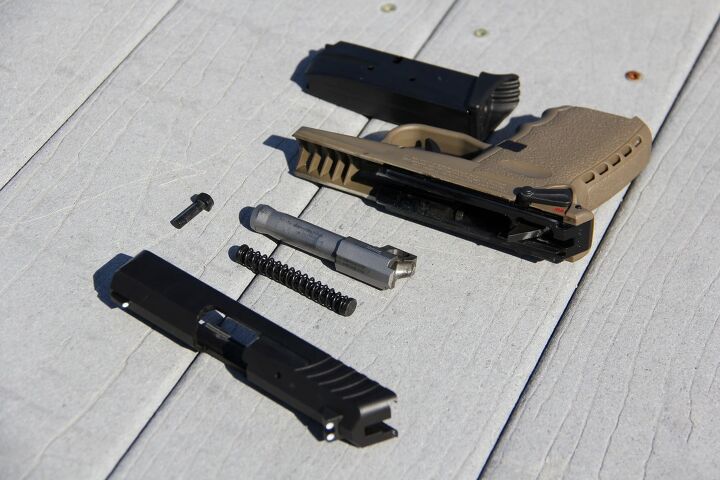
The Sccy broken down into its component parts. Note the non-captive takedown pin. In the author’s opinion, this is a minor detriment to the appeal of the handgun.
Takedown of the Sccy has both good and bad elements. On the positive side, takedown is performed with the slide locked back at the slide stop. This is a feature I wish more handguns had, as I think it greatly eases disassembly, especially for those with weak hands. The steel takedown pin is removable through the use of the case head of a piece of 9mm brass or a loaded 9mm cartridge. Admittedly, while on the range with it the first time, I did not think of this, and tried to remove the pin with my fingernail, which works much less well than using the proper “tool”. A negative aspect of disassembly in my opinion is that the pin is not captive in the frame. For the fastidious, I think this pin is big enough that it won’t be so easy to lose, but probably not every one of Sccy’s customers will be so careful. This is definitely not something that should prevent anyone from buying this handgun if it otherwise meets their needs, however.
The most outstanding part of the Sccy, though, is the warranty. Sccy ships each of their CPX-1 handguns with a lifetime, “no-questions asked” warranty; if the weapon is damaged or lost for any reason, Sccy will replace the firearm. In my opinion this is an absolutely huge factor for the target market for this handgun. When buying a firearm for everyday carry, one of the biggest factors in my mind is how easy the weapon will be to replace (to this end, I carry a Glock 19). In theory, it doesn’t get any easier to replace than the CPX-1. Further, the warranty is not tied to the owner; it is for each Sccy handgun and is tied to that weapon’s serial number. Even if the gun changes hands, it keeps its warranty. As far as I know, no other handgun is warranted to such an extent.
The Sccy handgun ships in two basic versions, the CPX-1 and CPX-2; the only difference being that the former, the handgun I tested, features dual ambidextrous manual safety levers; the -2 version lacking the manual safety. On a handgun like this, real-estate for features like manual safeties is limited. A designer has to then make a choice: They can either incorporate a small, difficult-to-use manual safety, no manual safety, or a large easy-to-inadvertently-disengage manual safety. Sccy chose the third option, but decided to overcome this weakness by adding large “wings” to the frame mold that protect the safety from inadvertent disengagement. This sounds like a great solution to a hard problem, but in practice these “wings” significantly interfered with my ability to use the handgun; having a proper grip meant having the wings being completely covered by my hand, digging into the skin. Under recoil, this was not very pleasant. Moving the hand down below the wings resulted in an awkward, low grip that clearly placed the hand below where the designer intended, and limited muzzle control. Because of this, I have to wonder whether the safety-less CPX-2 model wasn’t designed first; despite having the sequentially later designation. In my opinion, potential Sccy customers should absolutely choose the safety-less CPX-2 model, as it will be far easier to shoot and practice with than the manual safety CPX-1 model.
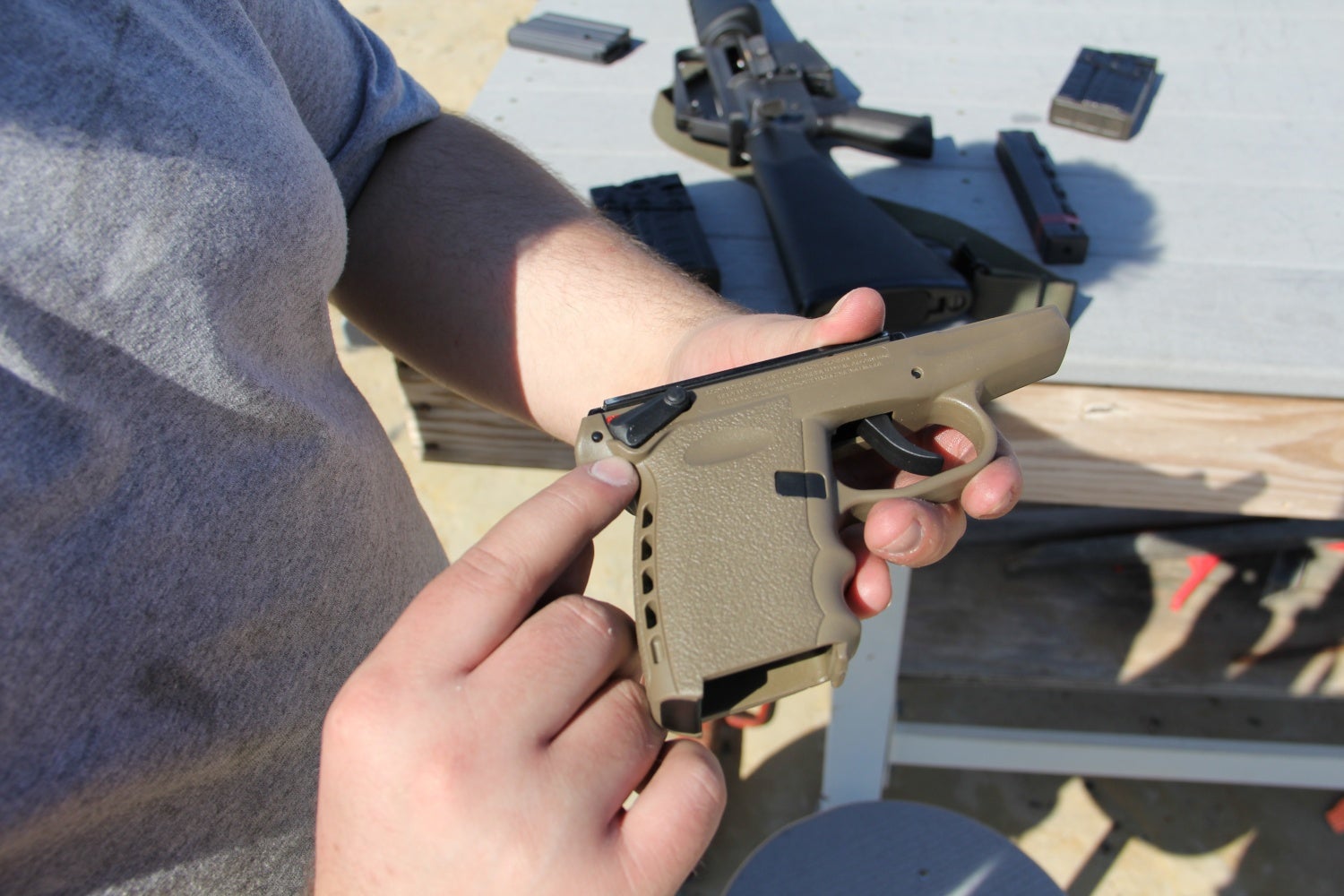
The author pointing out the “wings” protecting the safety levers, which considerably reduce the shootability of the CPX-1 model. The safety-less CPX-2 model does not suffer from this drawback.
Finally, the trigger of the CPX-1 is my major sticking point with this firearm. Its pull was smooth, with enough travel for safety, but not difficult to pull at all. However, the reset of the trigger only occurs at the very end of the trigger’s return; if the trigger isn’t returned to its full extended position after each shot, the gun will not fire again. On the range this was very worrying. Even though the gun was working perfectly fine, “short stroking” the trigger made it feel as if the gun was having a mechanical malfunction. In a life or death scenario, if the user of this handgun had not practiced with the trigger, it wouldn’t be difficult to imagine them desperately short stroking the trigger and getting nothing out of the handgun. This aspect of the firearm was very concerning to me, especially since it was coupled with an otherwise excellent product. I was unable to do any side by side comparison of the Sccy with any other comparable DAO handgun, so I am not able to give anything other than my impression that this trigger was unusual in this respect. I probably would recommend this handgun on its warranty alone to anyone looking for an everyday carry pistol, if not for the reset of this otherwise fine trigger pull.
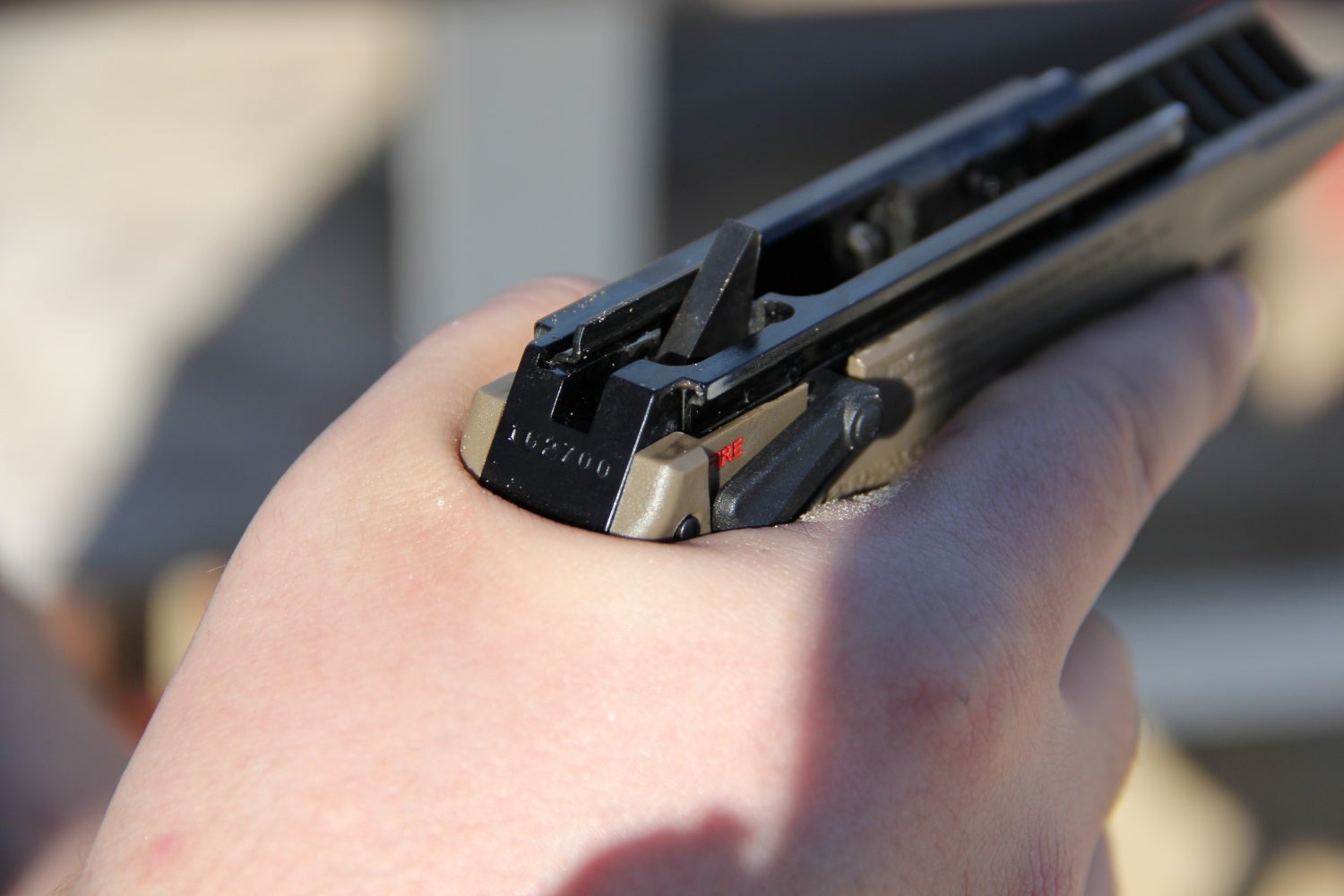
The author holding the Sccy in a high grip. This shot shows both the very simple wedge-shaped hammer, as well as the fact that when holding the handgun like this, the safety-protecting “wings” are completely covered by the shooter’s hands.
…Which isn’t to say I don’t recommend the Sccy. If the potential buyer is willing to put in the range hours necessary to adapt to this trigger and make sure to give enough room for the reset after every shot, then I would certainly recommend this handgun based on its warranty and relative high quality alone. I would not necessarily recommend this firearm to a new shooter looking for convenient personal protection; I think the trigger would be very unforgiving for them. In a perfect world, every user would practice regularly with their firearms, but unfortunately not every one does, and for the loved one with an interest only in protection, I would choose something with more forgiving operation than the Sccy.
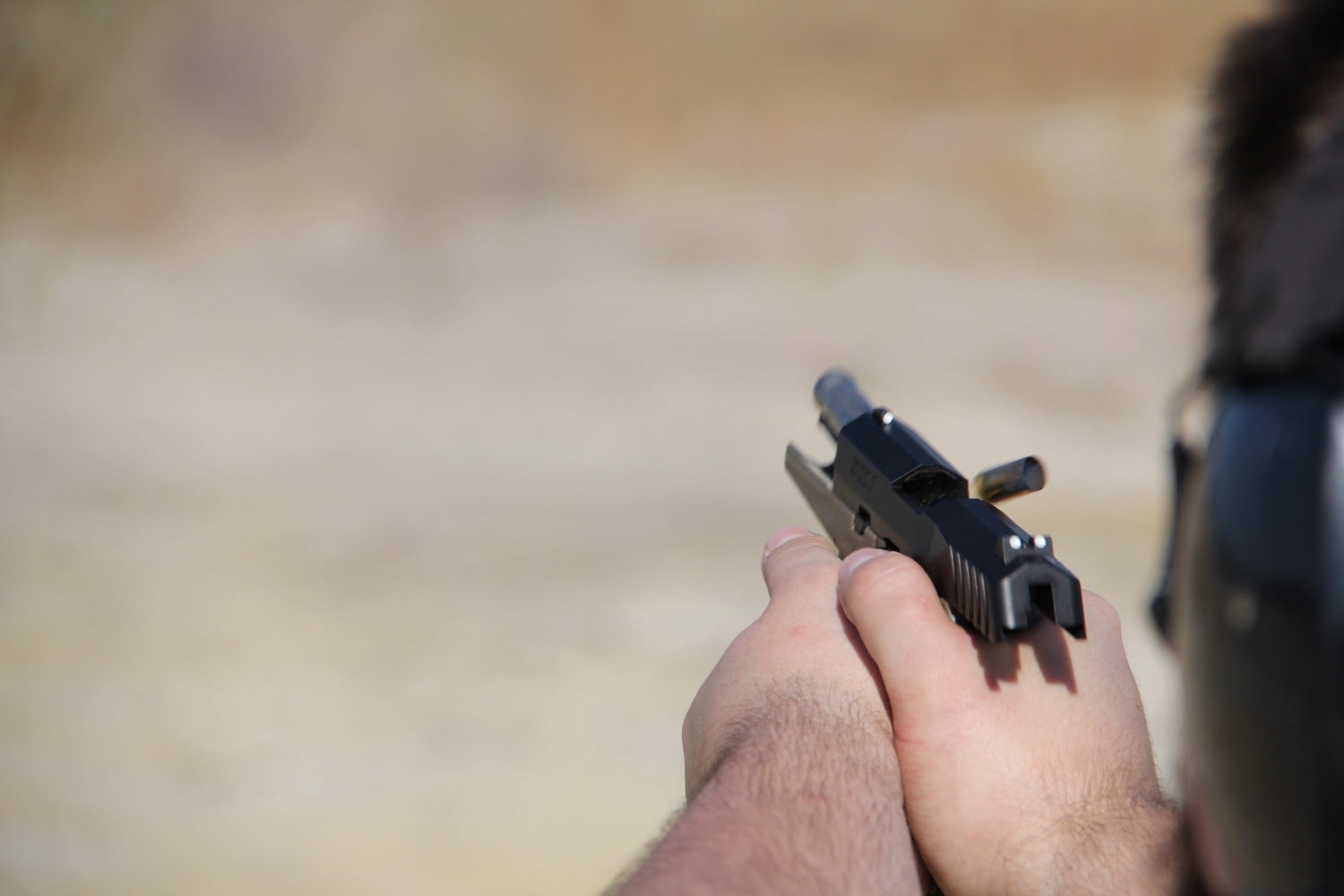
The Sccy in full recoil, showing its high visibility three-dot sights. For a Glock and CZ shooter like myself, this made for a very natural sight picture.
The handgun’s MSRP is $334, but they can be had for as little as $225 not including shipping or FFL fees through Gunbroker, making them highly affordable to the able deal-hunter. At the latter price, I would absolutely recommend the Sccy with its phenomenal warranty to the hobbyist-to-advanced-level shooter looking for an inconspicuous everyday carry gun that he or she does not care too much about to lose. I would also recommend the Sccy to the new shooter who is willing to put in the time to properly learn to use the weapon they are going to depend on, and who can train themselves to deal with the unforgiving trigger. For the new handgun owner who isn’t otherwise interested in the shooting sports, I would recommend a different firearm.
We are committed to finding, researching, and recommending the best products. We earn commissions from purchases you make using the retail links in our product reviews. Learn more about how this works.
 Your Privacy Choices
Your Privacy Choices